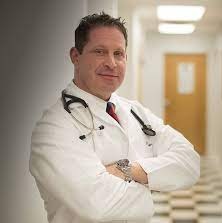Top 8 Bodybuilding Myths Debunked
This post is solely dedicated to exposing the myths and lies that have survived through the bodybuilding ages.
The following bodybuilding myths are as fictional as the tooth fairy, yet many gymgoers regard them as gospel truth.
By the end of this article, we will clarify the facts, cut through the industry’s nonsense, and enable you to improve your ‘bodybuilding IQ’.

Contents
- 1 8 Bodybuilding Myths
- 2 Myth 1: It’s Impossible to Stay Ripped Year-Round
- 3 Myth 2: You Cannot Build Muscle and Burn Fat at the Same Time
- 4 Myth 3: Clean Bulk Prevents Fat Gains
- 5 Myth 4: Everyone is on Steroids or PEDs
- 6 Myth 5: You Need Supplements
- 7 Myth 6: You Need to Eat Healthy to Get Lean
- 8 Myth 7: You Need to Lift Heavy to Build Muscle
- 9 Myth 8: All Hollywood Actors Are Juicing
- 10 Summary
8 Bodybuilding Myths
Myth 1: It’s Impossible to Stay Ripped Year-Round
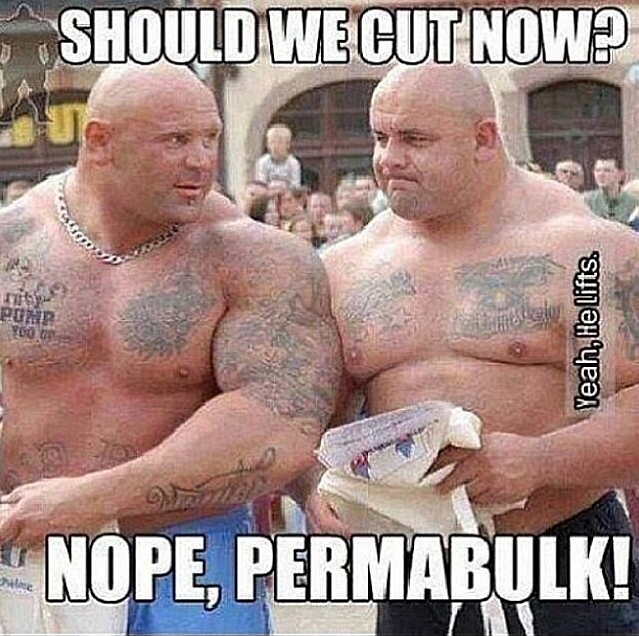
Contrary to common belief, it is possible to stay ripped year-round.
When I was at 6% body fat, it was relatively easy to maintain, and I wasn’t eating clean or doing cardio.
How did I do it?
I was conscious of how much I ate and made sure I didn’t overeat. This was straightforward because I wasn’t very hungry, with my metabolism having slowed down.
Your metabolism can naturally slow as you lose weight and become lighter, but that doesn’t mean you have to gain fat. Naturally, your body adapts to this by decreasing your hunger. So, it’s the same rule as if you had a rapid metabolism; once you are satisfied, if you continue eating more food past this point, you’ll almost certainly gain fat.
The probability of accumulating fat has little to do with your current body fat percentage, unless you’re exceptionally lean (2 or 3%). In this case, the body may begin to store fat as a survival mechanism to protect your internal organs. However, at 6%, this is unlikely to be the case and is generally healthy.
Thus, instead of eating the whole Domino’s pizza, you might just need to make do with 3 slices. Or, if you do want the whole pizza, you can refrain from eating anything else for the rest of the day.
Myth 2: You Cannot Build Muscle and Burn Fat at the Same Time
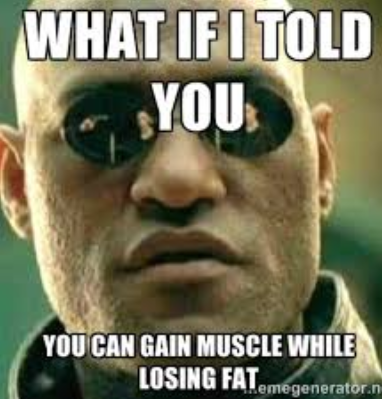
They’ll tell you this goal is impossible unless you’re a beginner experiencing newbie gains.
This is because many preach that a calorie surplus contributes to muscle gains (true) and a calorie deficit causes fat loss (true). Thus, some argue that you can’t have an excess of calories and a deficit at the same time. It’s one or the other.
However, individuals with this perspective do not understand that a calorie surplus isn’t the only way to build muscle.
There are other methods, such as overloading the muscle by utilizing new exercises, slower reps, supersets, a thick bar, heavier weight, and more reps.
I have personally gained around 4 kg of lean mass when cutting, simply by drastically changing my workouts every week.
I was constantly overloading the muscles while in a calorie deficit, and although my body fat was decreasing, the scales wouldn’t budge. Yet in the mirror, my body was drastically different—looking much leaner and more muscular at the same weight.
Sure, if you train in a very mundane way, you probably won’t build muscle and burn fat simultaneously. It is a challenge and may not be easily achieved. But this goal is certainly possible, whether you’re a beginner or a seasoned bodybuilder.
Myth 3: Clean Bulk Prevents Fat Gains
Some people believe that if you eat healthy foods when bulking and eat in a small calorie surplus of 500, you’ll build muscle while keeping fat at bay. I have not found this to be true.
In this instance, I built a small amount of muscle, but my body fat percentage also increased by a small amount.
I have done 10 years’ worth of bulking, gaining a combined total of 200 lbs in weight. If you want to gain muscle without adding fat, keep your calories at maintenance and switch up your workouts frequently, thus overloading your muscles and increasing growth.
Otherwise, you may need to eat more calories to grow. Accumulations in body fat are often hidden in the offseason under clothes anyway, and by the time you’re finished bulking, you’ll be extra motivated to cut because you’ll likely be fed up with eating copious amounts of food. After a bulk, motivation for a bodybuilder can be high if people are making comments about their weight.
Myth 4: Everyone is on Steroids or PEDs
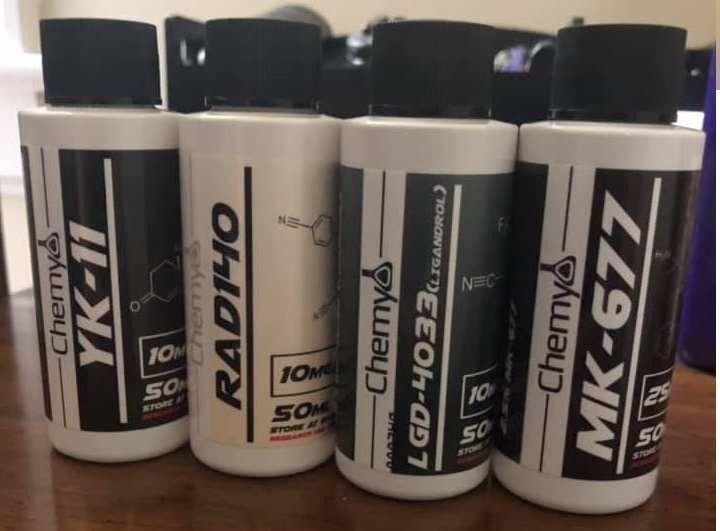
How many times have you heard someone calling out an individual for “using steroids”—completely discrediting that person’s insane physique without any evidence whatsoever?
Okay, yes, in some instances, they are correct, but sometimes such accusations are false. I know because I’ve been on the receiving end of such comments myself.
It is unfair to say someone is taking steroids or SARMs when in fact they are not. Unfortunately, some of the “bodybuilding community” believe anyone big is taking steroids. Such individuals may have obtained their “knowledge” from uninformed websites such as nattyornot.com, which are largely opinion-based.
However, it is true that increasingly more people are taking steroids today (1). This is partly due to bodybuilding becoming more mainstream.
The more people who compete in a sport, the more that sport will evolve in terms of having better athletes. It’s simply a numbers game. If you have 1 million people, you might find 100 genetic phenomena. If you have 30 million people, you might find 3,000 genetically blessed individuals. Consequently, it’s more common to find bigger natural bodybuilders today than it was 50 years ago (when bodybuilding was practically considered taboo).
So, people need to stop accusing others of taking steroids, because they may be wrong, and it’s unfair to those who are actually natural.
Myth 5: You Need Supplements
I have recommended supplements in the past because I needed to make a living (like many others in the fitness industry), but I’m not going to lie about how effective they are.
You do not need supplements to build muscle.
Natural supplements should generally be considered as a ‘surplus’ or a ‘bonus’ when it comes to enhancing your body composition.
How do you think people like Steve Reeves, Reg Park, Melvin Wells, and Eugene Sandow built muscle in the pre-steroid era?
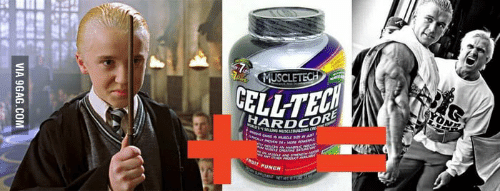
Proof Supplements and Steroids Aren’t Compulsory
A worthy example is Melvin Wells; see below how similar he looks to Simeon Panda. Melvin Wells was a natural bodybuilder in the 1940s (before steroids were used). In contrast, Simeon Panda is accused of being a “steroid fraud” today, with many claiming he’s too big to be natural. Simeon, however, strongly denies these accusations.

Melvin Wells vs. Simeon Panda 1940s vs. 2010s
I’m not giving my opinion on whether Simeon Panda is 100% natural, but I am saying it’s possible to get that big without taking drugs, as Melvin Wells proved.
What people fail to understand is that pre-steroid bodybuilders trained very hard and ate well, resulting in them getting big naturally. Combine this with exceptional genetics, and you have Melvin Wells.
There weren’t supplements like BCAAs, whey protein, or creatine powders like today. They practiced the basics without getting caught up in the “supplement hype.”
Many supplement companies exaggerate the benefits of their products, causing people to think they need such supplements for an improved physique.
It is unlikely a person would need any supplements to build muscle or burn fat. However, individuals do need to eat an appropriate amount of calories, tailored to their goals, and train smart for better results.
If you’ve reached your genetic potential, taking a testosterone booster or taking large quantities of BCAAs is very unlikely to do anything, despite what supplement companies may tell you.
Some supplement companies, if you didn’t already know, are notorious for their dishonesty and frequently face fraud charges.
Bodybuilding.com was fined $7m back in 2012 for spiking supplements with steroids (2).
Furthermore, some brands feel the urge to spike their formulas with illegal ingredients.
Craze was also fined for containing illegal and meth-like stimulants in their pre-workout supplements (3).
Myth 6: You Need to Eat Healthy to Get Lean

Eating healthy is always advised for optimal health. However, you do not need to eat healthily to have an excellent physique.
I lost 30 pounds of fat and got ripped by eating junk food every day (I do not recommend doing this). It certainly was not healthy, but it was a test to see if weight loss can be achieved by eating unhealthy foods.
The types of foods you eat can affect your body composition, but how much food you eat is a lot more important.
However, we recommend eating healthy long-term, because you don’t want to look strong but then have your organs slowly get weaker. That’s like having a Ferrari with the engine of a Mini Cooper.
IIFYM (if it fits your macros) is a dieting methodology that’s gone viral in the last decade, obliterating this myth of having to constantly eat healthy to be in good shape (4).
However, with the IIFYM protocol, people still believe you need to eat in certain macronutrient ratios to make gains. In my personal experience, macronutrient ratios have no noticeable effect on body composition either.
For the unaware, the IIFYM theory protocol consists of a person eating whatever they want, as long as they hit the right quantities of protein, carbs, and fats. For example, such ratios may be 30/40/30.
What IIFYM followers don’t realize is that they could be saving a lot of time not working out these ratios by simply hitting a calorie number instead. Calories are the most important number here in my experience, not the quantities of macronutrients.
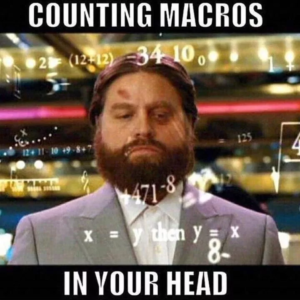
Myth 7: You Need to Lift Heavy to Build Muscle
Here’s a classic gym example: a dude wants to get big and is prone to lifting heavy. He’s usually very dedicated, doesn’t miss any sessions, and hangs out in the squat rack (or can regularly be seen doing deadlifts).
Even though he’s not muscular, he’s actually pretty strong. His numbers keep going up, but his muscles don’t seem to get any bigger.
What’s going wrong?
He’s lifting too heavy. Time under tension is crucial for muscle growth. If you’re lifting insanely heavy, your muscles are only going to be working for a few seconds. This is unlikely to be enough to stimulate any noticeable muscle growth. Furthermore, if you’re lifting super heavy, it’s very taxing on the central nervous system, so you are unlikely to be able to do many sets. Also, rest time in between sets will increase, decreasing the total volume.
MYTH: More repetitions are better for toning
You can lift super-light weights, do loads of reps, and experience exceptional muscle growth. I’ve tested this myself and have observed many real-world examples of it.
Look at a mechanic’s forearms, a cyclist’s calves, or a rock climber’s lats. These guys aren’t lifting insanely heavy weights for just a few seconds. Instead, they are doing constant movements for several hours throughout the day with lighter weights.
If a mechanic were to lift super-heavy weights all the time, he’d soon burn out. Instead, he lifts lighter weights, and his forearms are constantly stimulated for many hours each week. As a result, the strength and size of his forearms are superior to those of most bodybuilders.
The same forearm principle can apply to chefs.
It also applies to prisoners who get huge in prison. Some inmates can’t even access prison gyms; instead, they do countless pushups, dips (on their beds), and body-weight squats for hours every day.
Yes, some of them do smuggle in steroids, but others get big naturally from exceptional amounts of time under tension.
Myth 8: All Hollywood Actors Are Juicing

Some Hollywood actors are on anabolic steroids, but you’d be surprised how many aren’t.
The truth is, in order to get into insane shape, it often requires burning significant amounts of fat and building a small amount of muscle.
This is very attainable without drugs if the person works very hard over the course of several months.
People often forget that Hollywood actors have only made it that far due to being exceptionally hard-working individuals. Thus, if a personal trainer gives them a grueling workout routine to stick to for 6 months, it’s a piece of cake for them. But how many average gymgoers would give up after a couple of months? New Year’s resolution gym-goers come to mind.
Chris Hemsworth is one actor whom everyone just assumes took steroids because he’s jacked. However, not many people know that Chris Hemsworth’s genetics for bodybuilding appear to be incredible. Before he even started lifting weights to play the role of Thor, he looked like this:
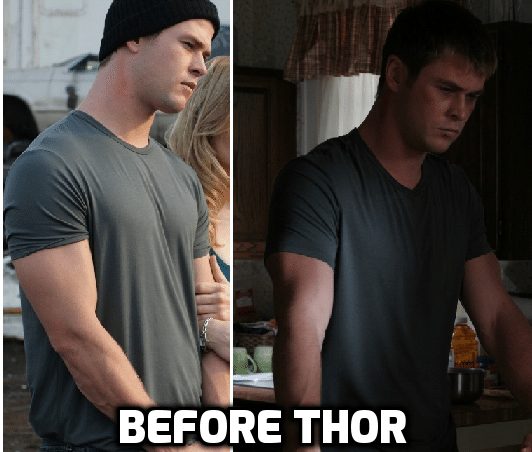
This is in Cash prior to the first Thor movie, before he started lifting weights. As you can see, he looks big in a T-shirt for someone who doesn’t even lift weights. Thus, when he started training, he added 20 pounds (normal “newbie gains”) of muscle and blew up.
Chris’ gains don’t correlate with steroid gains whatsoever, yet some people are adamant that just because he’s in excellent shape, he’s taking PEDs.
Summary
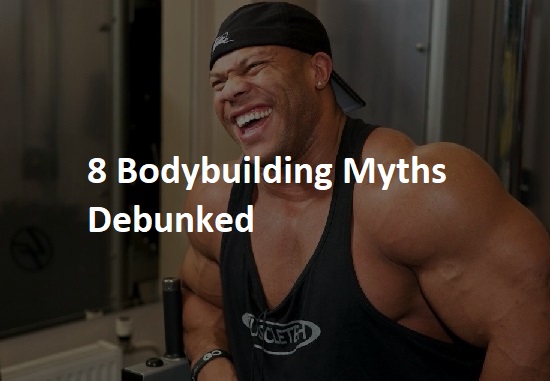
There are various other bodybuilding myths that have not been mentioned in this article, and there is a lot of misinformation in the bodybuilding world. The fastest way to know what works and what doesn’t is to test everything yourself rather than relying on anecdotal evidence from others or clinical studies. Real results do not lie.
Are there any bodybuilding myths that I didn’t mention that you’d like to expose? Have your say in the comments below.
References
(1) https://www.ncbi.nlm.nih.gov/books/NBK538174/#:~:text=endogenous%20male%20hormone.-,Androgen%20use%20has%20become%20a%20major%20public%20health%20concern%20due,to%205%25%5B1%5D.
(2) https://www.nutraingredients-usa.com/Article/2012/06/05/Bodybuilding.com-steroids-spiking-guilty-plea-is-a-wake-up-call-for-industry-says-lab-director
(3) https://www.webmd.com/drug-medication/news/20131014/craze-sports-supplement
(4) https://www.ncbi.nlm.nih.gov/pmc/articles/PMC8243453/
Inside Bodybuilding is a team of medical professionals and physicians with specialized knowledge and experience regarding bodybuilding and PEDs.


